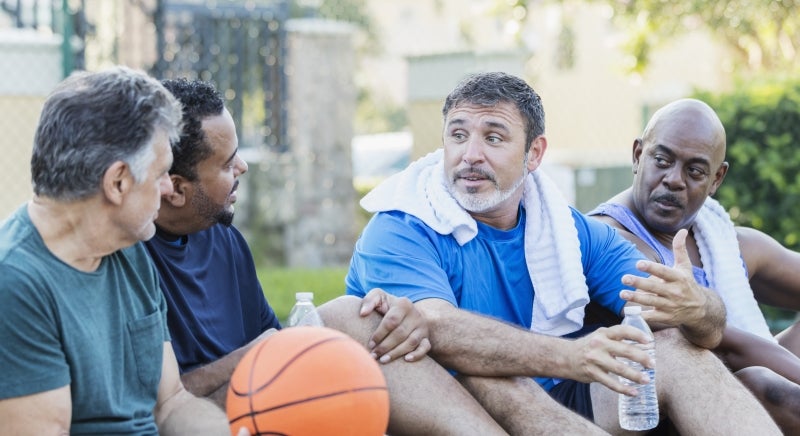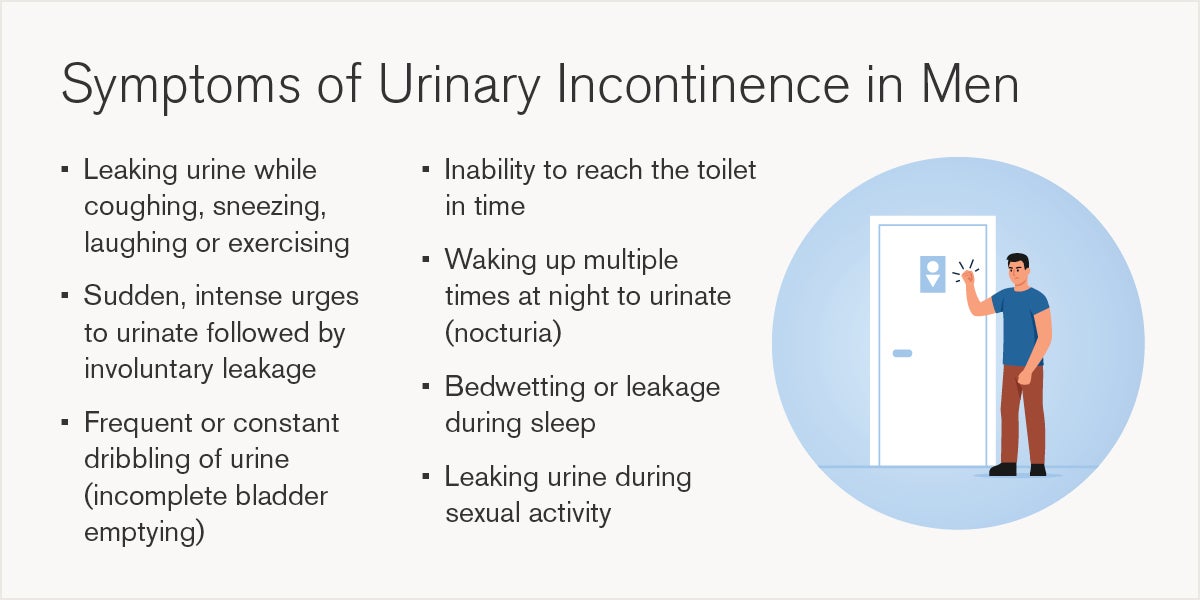Male Urinary Incontinence: Symptoms, Causes and Treatment Options
October 13, 2025
Categories: Men's Health, Urology
Tags: Urinary Incontinence Surgery, Male Urinary Incontinence
Urinary incontinence, or the involuntary leakage of urine, affects a significant number of men. While exact numbers are not known for the prevalence of urinary incontinence, recent research suggests that more than 10% of men above the age of 60 and 30% above the age of 85 experience this condition. While often seen as a mere inconvenience, urinary incontinence can signal more serious underlying health issues.
Types of male urinary incontinence
Understanding the types of male urinary incontinence is important for identifying the most effective treatment options.
Urge incontinence (overactive bladder)
Urge incontinence is characterized by a sudden, intense need to urinate, followed by an involuntary loss of urine. This condition is often linked to an overactive bladder, where the bladder muscles contract too often or without warning. People with urge incontinence may find themselves rushing to the bathroom frequently, even waking up multiple times at night. Triggers can include the sound of running water, cold temperatures, or even just thinking about urinating.
Stress incontinence
Stress incontinence occurs when physical movement or activity, such as laughing, coughing, sneezing, running, or lifting heavy objects, puts pressure on the bladder, causing leakage. This type is especially common in men following prostate surgery. It’s typically caused by weakened pelvic floor muscles or a compromised urethral sphincter.
Overflow incontinence
Overflow incontinence happens when the bladder doesn’t empty completely, leading to frequent or constant dribbling of urine. It may feel like the bladder is always full, and urination may be weak or intermittent. This condition is often due to a blockage (like an enlarged prostate), weak bladder muscles, or nerve damage that interferes with bladder signals.
Mixed incontinence
Mixed incontinence is a combination of both stress and urge incontinence. Individuals may experience leakage both when they feel a sudden urge to urinate and during physical activities that increase abdominal pressure.

Causes of male urinary incontinence
Urinary incontinence can stem from a wide range of factors, some of which are short-term and reversible, while others are more persistent and require long-term management. Understanding the root cause is essential for choosing the right treatment approach. These causes are generally grouped into temporary and chronic categories:
Temporary causes
Temporary causes of incontinence are often related to lifestyle choices, medications, or short-term health conditions. These factors can irritate the bladder or increase urine production, but they typically resolve once the underlying issue is addressed.
- Dietary triggers: Certain foods and drinks, such as caffeine, alcohol, carbonated beverages, spicy foods, and artificial sweeteners, can irritate the bladder or act as diuretics, increasing the urge to urinate.
- Medications: Diuretics, sedatives, muscle relaxants, and some antidepressants can interfere with bladder control by either increasing urine output or relaxing the bladder muscles.
- Urinary tract infections: Infections can inflame the bladder lining, leading to a strong, sudden urge to urinate and, in some cases, leakage.
- Constipation: A full rectum can press against the bladder and disrupt normal nerve signals, making it harder to control urination.
- Excess fluid intake: Drinking large amounts of fluid in a short time can overwhelm the bladder, especially if it’s already weakened.
Chronic causes
Chronic causes are typically structural or neurological and tend to persist over time. These often require ongoing treatment or lifestyle adjustments to manage symptoms effectively.
- Aging: As people age, bladder capacity may decrease and involuntary bladder contractions become more common, increasing the risk of incontinence.
- Prostate conditions: An enlarged prostate or prostate surgery can interfere with normal urine flow and bladder control.
- Neurological disorders: Conditions such as Parkinson’s disease, multiple sclerosis, stroke, or spinal cord injuries can disrupt the nerve signals between the brain and bladder.
- Bladder obstructions: Tumors, urinary stones, or scarring can block the flow of urine, leading to overflow incontinence.
- Obesity: Excess body weight increases pressure on the bladder and pelvic floor, weakening the muscles that help control urination.
How is incontinence diagnosed?
Diagnosis typically begins with a medical history review and physical exam, where your provider will ask about your symptoms, lifestyle, and any underlying conditions. You may also be asked to keep a bladder diary to track fluid intake, urination patterns, and leakage episodes.
To confirm the type and cause of incontinence, a few common tests may be performed:
- Urinalysis: Checks for infections or other abnormalities.
- Postvoid residual test: Measures how much urine remains in the bladder after urination.
- Bladder stress test: Observes leakage during coughing or straining.
- Urodynamic testing: Assesses how well the bladder and urethra store and release urine.
These tests help determine the most appropriate treatment plan based on the specific type of incontinence.
Treatment options for urinary incontinence
There are many treatment options for urinary incontinence, ranging from simple lifestyle changes to surgery.
Lifestyle changes
Weight loss can significantly reduce the frequency and severity of urinary leakage. Maintaining a healthy weight not only minimizes incontinence episodes but also contributes to overall well-being and quality of life.
Fluid intake and diet can also play a significant role in your incontinence. Cutting down on or eliminating bladder irritants like alcohol, caffeine, acidic foods, and artificial sweeteners can lessen your incontinence. You can also keep a bladder diary to help identify which foods and drinks trigger symptoms.
Bladder training
Bladder training uses techniques to improve control over urinary urges and reduce the frequency of incontinence episodes. This includes scheduling bathroom visits or practicing techniques to start and stop your stream during these visits.
Pelvic floor exercises
If you've undergone prostate surgery, whether that be for prostate cancer or an enlarged prostate, you may experience urinary leakage due to weakened pelvic floor muscles. Strengthening these muscles through pelvic floor exercises, such as Kegel exercises, can greatly improve bladder control. Incorporating these exercises into your daily routine can lead to significant improvements in urinary health and overall quality of life.
Medications and surgical interventions
For some men, lifestyle changes, bladder training and pelvic floor exercises may not be enough to address their symptoms. Medications or surgical options may be necessary to manage urinary incontinence, depending on the type of incontinence.
For men with urinary incontinence after prostate surgery, procedures such as a male urethral sling or artificial urinary sphincter, can restore the function of the urinary sphincter and pelvic floor in providing continence. These surgeries have an especially high success rate.
Don’t hesitate to ask questions about potential treatments, lifestyle changes, and preventive measures. Remember, urinary incontinence is a common condition, and your doctor is there to help you find the best solutions for your health and well-being.
If you experience symptoms of urinary incontinence, consult with a Loyola Medicine health care professional to explore the best treatment options. Visit loyolamedicine.org/urology to learn more.
Book an appointment today to see Dr. Ahmad El-Arabi or another Loyola Medicine urologist by self-scheduling an in-person or virtual appointment using myLoyola.

